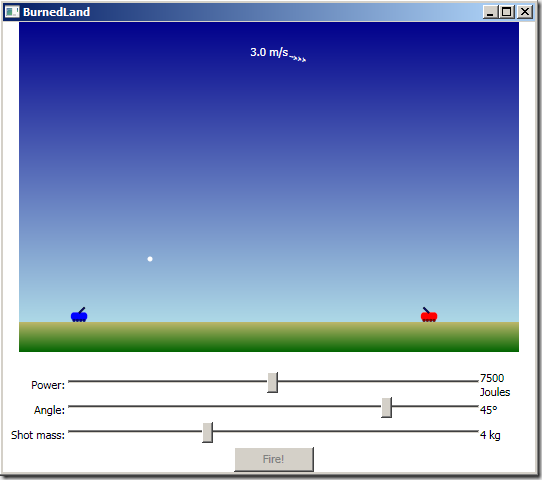Simple F# Game using WPF
With the F# CTP out the door, let’s take a look at what it can do.
Ryan Cavanaugh, not the famous Banjo Player, the one on the VS Pro Tools Team, helped me put together an artillery game called BurnedLand. (Kudos if you can catch the subtle reference.) To play the game you adjust the Power, Angle, and Mass of your cannon ball so that when you fire it will (hopefully) hit the red tank.
In this post I’d like to highlight how this project takes advantage of:
- The F# Project System
- Units of Measure
- WPF and data binding
The F# Project System
Rather than lumping all the code together into a single project, I separated out the game logic into an F# library and left all the UI in a C# WPF application. Since the F# Project System now supports project-to-project references, this all ‘just works’ like you would expect. If you tried multi-project development in the previous MSR Research releases, you know just what a pain this used to be.
Also, check out the sexy new F# icons!
Units of Measure
For calculating the cannon ball’s trajectory, you have to factor in gravity, velocity, position, time, etc. Using Units of Measure ensures that logic errors are caught at compile time by double-checking your math. (Check out Andrew’s blog for more info.)
Here’s a simpler example. Notice that multiplying a value with unit <m/s^2> by <s> * <s> results in a value with unit <m>.
Windows Presentation Foundation
One of the best features of WPF is databinding. Rather than programmatically updating UI elements whenever a value changes in the game logic module, you can use WPF data binding and the UI will always be in sync with no manual intervention.
For example, the game logic module in F# adds three simple properties for describing aspects of the Wind.
// ----- Wind -----
member this.Wind with get = m_wind
and set x = m_wind <- x
m_PropertyChanged.Trigger(this, new PropertyChangedEventArgs("Wind"))
m_PropertyChanged.Trigger(this, new PropertyChangedEventArgs("WindSpeed"))
m_PropertyChanged.Trigger(this, new PropertyChangedEventArgs("WindAngle"))
member this.WindAngle = Math.Atan2(float this.Wind.Y, float this.Wind.X) * (180.0 / Math.PI)
member this.WindSpeed = String.Format("{0:0.0} m/s", this.Wind.Length)
By using data binding in WPF, the values are automatically up to date. In fact, if the Wind property ever changes, the UI elements will be updated via the PropertyChanged event in the game logic class.
<!-- Wind indicator -->
<Grid Width="{Binding DefaultBounds.Width}">
<Border Width="60" Height="60" BorderBrush="White" CornerRadius="60" RenderTransformOrigin="0.5,0.5">
<TextBlock Text="-->>>" HorizontalAlignment="Right" VerticalAlignment="Center"
FontSize="6"
Foreground="White" Margin="-8" />
<Border.RenderTransform>
<RotateTransform Angle="{Binding WindAngle}" />
</Border.RenderTransform>
</Border>
<TextBlock Text="{Binding WindSpeed}" HorizontalAlignment="Center" VerticalAlignment="Center" Foreground="White" />
</Grid>
So the WPF value "{Binding WindSpeed}" is really a call to the F# code.
Disclaimer: All code samples are provided "AS IS" without warranty of any kind, either express or implied, including but not limited to the implied warranties of merchantability and/or fitness for a particular purpose. So in other words, if the attached source files cause you any grief whatsoever you can’t blame me or Microsoft.
Comments
Anonymous
September 03, 2008
PingBack from http://blog.a-foton.ru/2008/09/simple-f-game-using-wpf/Anonymous
September 05, 2008
The comment has been removedAnonymous
September 05, 2008
For the data binding in the WPF-side to work, the F# library needs to be built first. If you build the F# project first and then open the WPF designer (or click 'Reload'), things should work as you expect. Is that not the behaivor you are seeing?Anonymous
September 05, 2008
I've had issues with removing VSLab F# 1.9.4... maybe this is what I'm seeing. Prob needed to confirm that is OK first.Anonymous
September 05, 2008
Regedit'd to fully uninstall VSLab. BurnedLand Builds OK now; Vista VS 2008 F# 1.9.6.0. Thanks.Anonymous
February 25, 2009
- What is F#? It is a functional language that is capable of object oriented programming and eases multi-cpu
Anonymous
April 07, 2009
It used to be that rockets and research were two words that went together. Now, rockets aren’t quiteAnonymous
May 07, 2009
digg_url = "http://blogs.msdn.com/research/archive/2009/05/07/f-ballistics-rocketry-and-research-5-7-2009.aspx";digg_title



